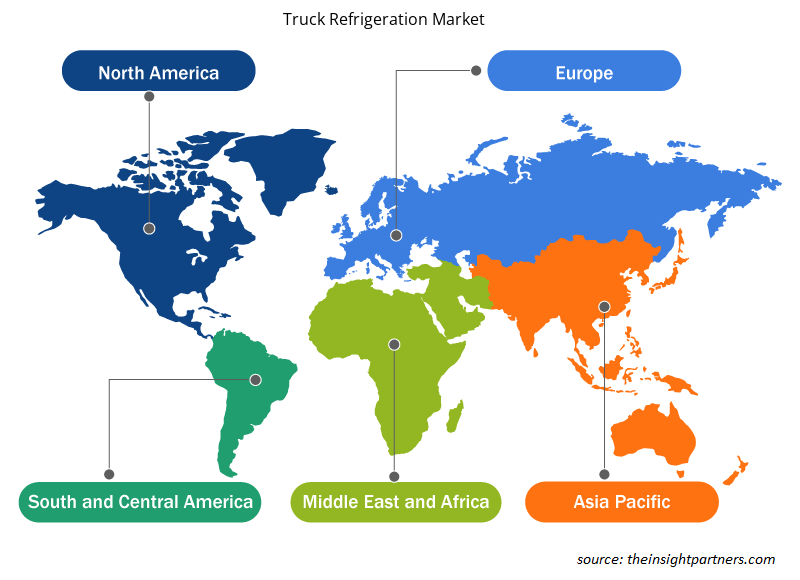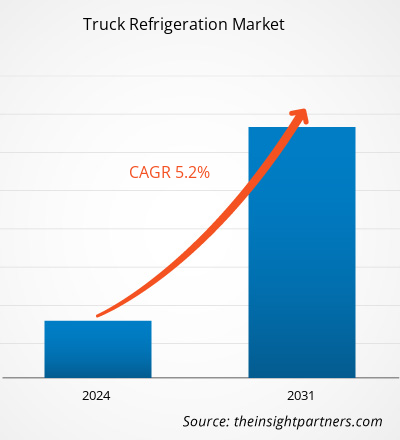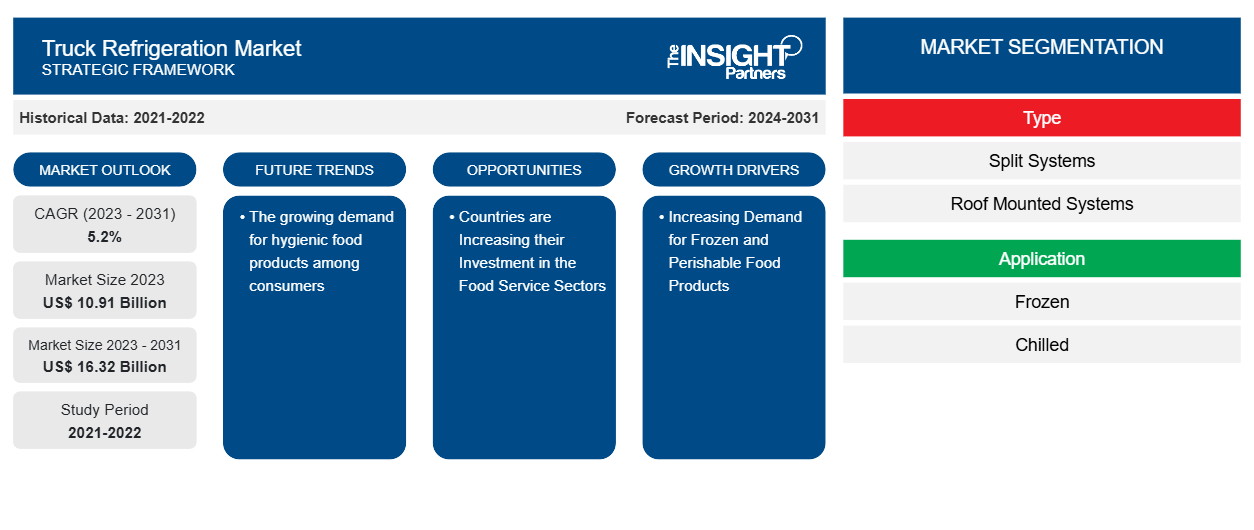Se proyecta que el tamaño del mercado de refrigeración para camiones alcance los 16.320 millones de dólares en 2031, frente a los 10.910 millones de dólares en 2023. Se espera que el mercado registre una CAGR del 5,2 % entre 2023 y 2031. Es probable que la creciente demanda de productos alimenticios higiénicos entre los consumidores siga siendo una tendencia clave en el mercado de refrigeración para camiones.
Análisis del mercado de refrigeración para camiones
El mercado de refrigeración para camiones está creciendo a un ritmo rápido debido a la creciente demanda de productos alimenticios congelados y perecederos y a la expansión de supermercados y restaurantes como Subways, Domino y KFC, entre otros. El mercado se está expandiendo de manera constante, impulsado por el enfoque de los fabricantes en reducir los desechos durante el transporte de productos. Además, los países están aumentando su inversión en los sectores de servicios de alimentos, y la creciente demanda de sistemas avanzados de control y monitoreo de temperatura en camiones está brindando oportunidades lucrativas para el crecimiento del mercado.
Descripción general del mercado de refrigeración para camiones
La refrigeración de camiones se refiere a los sistemas instalados en los camiones para mantener temperaturas específicas para el transporte de diversos productos perecederos, incluidos alimentos, productos químicos y farmacéuticos. Estos sistemas utilizan unidades de refrigeración impulsadas por el motor de un camión o fuentes de energía independientes. Los importantes beneficios que ofrece la refrigeración de camiones a los usuarios están impulsando el mercado durante el período de pronóstico. Estos sistemas se utilizan para mantener una temperatura óptima y preservar la calidad y la seguridad de los artículos durante el transporte al aumentar la vida útil del producto y reducir el desperdicio.
Personalice este informe según sus necesidades
Obtendrá personalización en cualquier informe, sin cargo, incluidas partes de este informe o análisis a nivel de país, paquete de datos de Excel, así como también grandes ofertas y descuentos para empresas emergentes y universidades.
-
Obtenga las principales tendencias clave del mercado de este informe.Esta muestra GRATUITA incluirá análisis de datos, desde tendencias del mercado hasta estimaciones y pronósticos.
Factores impulsores y oportunidades del mercado de refrigeración para camiones
La creciente demanda de productos alimenticios congelados y perecederos está impulsando el mercado
El aumento del consumo de alimentos congelados, refrigerados y perecederos impulsará el mercado mundial de camiones refrigerados en el futuro cercano. Los cambios en los estilos de vida y los hábitos alimentarios de los consumidores, así como sus agitados horarios, están impulsando la demanda de alimentos refrigerados, envasados y congelados. Además, el mercado está impulsado por la necesidad de transportar una variedad de alimentos con diversos requisitos de temperatura a la vez. Estos camiones ayudan a mantener los alimentos seguros y frescos mientras se transportan. Los camiones están equipados con equipos de refrigeración que mantienen los alimentos frescos y seguros. Estos camiones transportan alimentos y bebidas frescos desde las instalaciones de producción hasta los almacenes y lugares de distribución. Además, el aumento de los ingresos disponibles conduce a un mayor consumo de alimentos preparados. Sin embargo, un aumento en el número de restaurantes y supermercados, que crea una demanda favorable de camiones refrigerados, está impulsando el mercado.
Los países están aumentando su inversión en los sectores de servicios alimentarios: una oportunidad en el mercado de refrigeración para camiones
Países como China e India están aumentando su inversión en los sectores de servicios de alimentación, lo que se espera que cree oportunidades en el mercado mundial de refrigeración para camiones. La gran importancia del sector agroindustrial en países emergentes como India, China, Brasil y otros aumenta la demanda de refrigeración para camiones para conservar productos agrícolas. Estos países están invirtiendo fuertemente en el sector de servicios de alimentación mediante la expansión de la logística de la cadena de frío , lo que genera una mayor demanda de camiones refrigerados, lo que se prevé que cree importantes oportunidades de crecimiento en el mercado durante el período de pronóstico.
Análisis de segmentación del informe del mercado de refrigeración para camiones
Los segmentos clave que contribuyeron a la derivación del análisis del mercado de refrigeración de camiones son el tipo, la aplicación, la vertical y el tipo de vehículo.
- Según el tipo, el mercado de refrigeración para camiones se divide en sistemas divididos y sistemas montados en el techo. El segmento montado en el techo tuvo una mayor participación de mercado en 2023.
- En función de la aplicación, el mercado se segmenta en productos congelados y refrigerados. El segmento de productos congelados tuvo una mayor participación de mercado en 2023.
- Según la vertical, el mercado de refrigeración para camiones se segmenta en alimentos y bebidas, productos farmacéuticos y químicos, y ambulancias. El segmento de alimentos y bebidas tuvo una mayor participación de mercado en 2023.
- En términos de tipo de vehículo, el mercado se clasifica en remolques y vehículos comerciales medianos y pesados. El segmento de remolques tuvo una mayor participación de mercado en 2023.
Análisis de la cuota de mercado de refrigeración para camiones por geografía
El alcance geográfico del informe del mercado de refrigeración de camiones se divide principalmente en cinco regiones: América del Norte, Asia Pacífico, Europa, Medio Oriente y África, y América del Sur / América del Sur y Central.
En términos de ingresos, Asia Pacífico representó la mayor participación en el mercado de refrigeración para camiones, debido al alto consumo de productos congelados y refrigerados. Los cambios en los estilos de vida, el aumento del gasto de los consumidores y la creciente demanda de conveniencia, entre otras cosas, están aumentando la demanda de alimentos congelados, verduras frescas y bocadillos, lo que a su vez está impulsando el mercado de refrigeración para camiones durante el período de pronóstico. Además, la presencia de actores importantes, incluidos Daikin Industries, Ltd., Denso Corporation y Sanden, entre otros, está creando oportunidades en el mercado. Estos actores se dedican al desarrollo de camiones innovadores para brindarles a sus clientes una mejor solución, impulsando el mercado.
Perspectivas regionales del mercado de refrigeración para camiones
Los analistas de Insight Partners explicaron en detalle las tendencias y los factores regionales que influyen en el mercado de refrigeración para camiones durante el período de pronóstico. Esta sección también analiza los segmentos y la geografía del mercado de refrigeración para camiones en América del Norte, Europa, Asia Pacífico, Oriente Medio y África, y América del Sur y Central.

- Obtenga datos regionales específicos para el mercado de refrigeración de camiones
Alcance del informe sobre el mercado de refrigeración de camiones
| Atributo del informe | Detalles |
|---|---|
| Tamaño del mercado en 2023 | US$ 10,91 mil millones |
| Tamaño del mercado en 2031 | US$ 16.32 mil millones |
| CAGR global (2023 - 2031) | 5,2% |
| Datos históricos | 2021-2022 |
| Período de pronóstico | 2024-2031 |
| Segmentos cubiertos |
Por tipo
|
| Regiones y países cubiertos |
América del norte
|
| Líderes del mercado y perfiles de empresas clave |
|
Densidad de actores del mercado de refrigeración para camiones: comprensión de su impacto en la dinámica empresarial
El mercado de refrigeración para camiones está creciendo rápidamente, impulsado por la creciente demanda de los usuarios finales debido a factores como la evolución de las preferencias de los consumidores, los avances tecnológicos y una mayor conciencia de los beneficios del producto. A medida que aumenta la demanda, las empresas amplían sus ofertas, innovan para satisfacer las necesidades de los consumidores y aprovechan las tendencias emergentes, lo que impulsa aún más el crecimiento del mercado.
La densidad de actores del mercado se refiere a la distribución de las empresas o firmas que operan dentro de un mercado o industria en particular. Indica cuántos competidores (actores del mercado) están presentes en un espacio de mercado determinado en relación con su tamaño o valor total de mercado.
Las principales empresas que operan en el mercado de refrigeración para camiones son:
- Corporación Global Carrier
- Industrias Daikin, Ltd.
- Corporación Denso
- Corporación Klinge
- Industrias pesadas Mitsubishi, Ltd.
- SCHMITZ CARGOBULL
Descargo de responsabilidad : Las empresas enumeradas anteriormente no están clasificadas en ningún orden particular.

- Obtenga una descripción general de los principales actores clave del mercado de refrigeración para camiones
Noticias y desarrollos recientes del mercado de refrigeración para camiones
El mercado de refrigeración para camiones se evalúa mediante la recopilación de datos cualitativos y cuantitativos posteriores a la investigación primaria y secundaria, que incluye publicaciones corporativas importantes, datos de asociaciones y bases de datos. A continuación, se incluye una lista de los avances en el mercado de refrigeración para camiones y las estrategias:
- En noviembre de 2023, Daikin Industries, Ltd. presentó sus últimas soluciones para refrigeración en furgonetas, camiones y remolques en SOLUTRANS, el centro mundial de vehículos comerciales ligeros y pesados. La gama de productos totalmente eléctricos e híbridos enchufables de Daikin reduce las emisiones de los motores de combustión interna. El fabricante mundial muestra sus innovaciones para la refrigeración del transporte, incluida su nueva unidad de refrigeración para remolques, Exigo, junto con la nueva plataforma de conectividad Daikin Telematics. (Fuente: Daikin Industries, Ltd., nota de prensa, 2023)
Informe sobre el mercado de refrigeración de camiones: cobertura y resultados
El informe “Tamaño y pronóstico del mercado de refrigeración para camiones (2021-2031)” proporciona un análisis detallado del mercado que cubre las siguientes áreas:
- Tamaño del mercado y pronóstico a nivel global, regional y nacional para todos los segmentos clave del mercado cubiertos bajo el alcance
- Dinámica del mercado, como impulsores, restricciones y oportunidades clave
- Principales tendencias futuras
- Análisis detallado de las cinco fuerzas de Porter y PEST y FODA
- Análisis del mercado global y regional que cubre las tendencias clave del mercado, los principales actores, las regulaciones y los desarrollos recientes del mercado.
- Análisis del panorama de la industria y de la competencia que abarca la concentración del mercado, el análisis de mapas de calor, los actores destacados y los desarrollos recientes
- Perfiles detallados de empresas
- Análisis histórico (2 años), año base, pronóstico (7 años) con CAGR
- Análisis PEST y FODA
- Tamaño del mercado, valor/volumen: global, regional y nacional
- Industria y panorama competitivo
- Conjunto de datos de Excel
Informes recientes
Informes relacionados
Testimonios
Razón para comprar
- Toma de decisiones informada
- Comprensión de la dinámica del mercado
- Análisis competitivo
- Información sobre clientes
- Pronósticos del mercado
- Mitigación de riesgos
- Planificación estratégica
- Justificación de la inversión
- Identificación de mercados emergentes
- Mejora de las estrategias de marketing
- Impulso de la eficiencia operativa
- Alineación con las tendencias regulatorias























 Obtenga una muestra gratuita para - Mercado de refrigeración para camiones
Obtenga una muestra gratuita para - Mercado de refrigeración para camiones